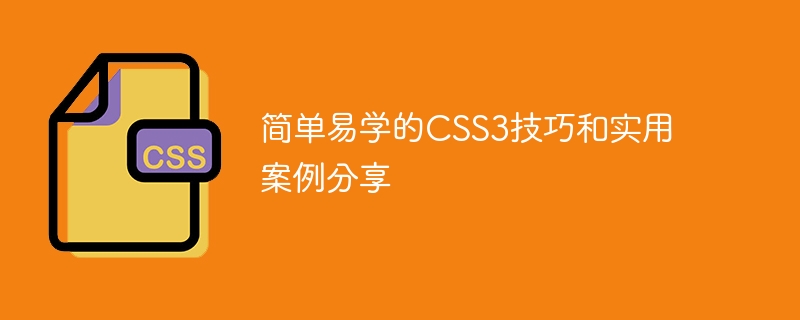Home >Web Front-end >CSS Tutorial >Easy-to-learn CSS3 skills and practical case sharing
Easy-to-learn CSS3 skills and practical case sharing
- WBOYWBOYWBOYWBOYWBOYWBOYWBOYWBOYWBOYWBOYWBOYWBOYWBOriginal
- 2023-09-09 14:06:231386browse

Easy-to-learn CSS3 skills and practical case sharing
CSS3 is the latest version of Cascading Style Sheets, which introduces many powerful features and effects. It can make web design more outstanding and rich. In this article, we will share some easy-to-learn CSS3 techniques and practical cases, hoping to help you improve your web design level.
1. Font styles and effects
Through CSS3, we can add various attractive styles and effects to text content. Here are some examples of font styles and effects:
- Text Gradient Effect
.gradient-text {
background: -webkit-linear-gradient(#FFD700, #FFA500);
-webkit-text-fill-color: transparent;
-webkit-background-clip: text;
}
.gradient-text:hover {
background: -webkit-linear-gradient(#FFA500, #FFD700);
}Text gradient effects can be achieved by using background gradients and text color transparency. Dynamic changes can be achieved by changing the gradient color on mouseover.
- Character stroke effect
.outline-text {
-webkit-text-stroke: 1px #000;
color: #FFF;
}By using the -webkit-text-stroke property to stroke the text and set the color and width, you can Achieve character stroke effect.
- Font shadow effect
.shadow-text {
text-shadow: 2px 2px 4px #000;
}By setting the text-shadow attribute, you can add a shadow effect to the text. Property values include the shadow's horizontal offset, vertical offset, blur level, and color.
2. Image and background effects
CSS3 provides many powerful image and background effects that can add visual impact to web pages. The following are some practical cases:
- Rounded corner border
.rounded-border {
border-radius: 50%;
}By setting the border-radius property to 50%, a square area can be Become circular. This is useful when making round avatars or round buttons.
- Transition effect
.transition {
transition: background 0.5s ease;
}
.transition:hover {
background: #FFD700;
}By using the transition attribute and transition time, you can achieve a smooth transition effect of elements. On mouseover, you can achieve a gradient transition of color by changing the background color.
- Gradient background
.gradient-background {
background: linear-gradient(#FFD700, #FFA500);
}By using the linear-gradient function, you can create a smooth gradient background. The parameters of the function include color and direction.
3. Animation and transition effects
CSS3 animation and transition effects can add vitality and interactivity to web pages. The following are some practical cases:
- Rotation animation
.rotate {
animation: rotate 5s infinite linear;
}
@keyframes rotate {
from {
transform: rotate(0deg);
}
to {
transform: rotate(360deg);
}
}By using the @keyframes and transform properties, this can be achieved Rotation animation of the element. In this example, the element will rotate infinitely in a linear fashion.
- Scale Transformation
.zoom {
transition: transform 0.5s ease;
}
.zoom:hover {
transform: scale(1.2);
}By using the transform attribute and the scaling function scale, the scaling effect of the element can be achieved. On mouseover, the element will scale by 1.2x.
4. Summary
CSS3 has many exciting and practical features that can greatly improve the look and experience of web design. This article shares some easy-to-learn CSS3 techniques and practical cases, involving font styles, image and background effects, as well as animation and transition effects. Hopefully this content will spark your creativity and help you design unique and eye-catching web pages. Come and try it!
The above is the detailed content of Easy-to-learn CSS3 skills and practical case sharing. For more information, please follow other related articles on the PHP Chinese website!

